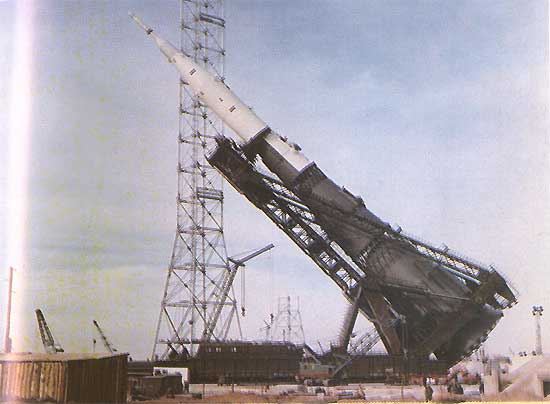Some finished renders of the Hyperion, Phil Bono’s SSTO design.
 This view has some perspective, and I have added a figure for scale. Continue reading “Bono’s Hyperion, finished renders”
This view has some perspective, and I have added a figure for scale. Continue reading “Bono’s Hyperion, finished renders”
The Art and Graphics of Nick Stevens. Available for hire.I specialise in unbuilt space projects, and the spacecraft of the Soviet Union.
Some finished renders of the Hyperion, Phil Bono’s SSTO design.
 This view has some perspective, and I have added a figure for scale. Continue reading “Bono’s Hyperion, finished renders”
This view has some perspective, and I have added a figure for scale. Continue reading “Bono’s Hyperion, finished renders”
Next up, another classic design from the fertile mind of Phil Bono, the Hyperion.
This is a large single stage to orbit (SSTO) design, which can launch via a rocket sled, (should there be a convenient nearby 1 mile high mountain, anyway).
Now added a video. complete with soundtrack, to showcase the mesh and the concept!
Continue reading “Video for the Krafft Erhike Space Station concept.”
 There’s a new book out by Michael Carroll, covering possible earthlike worlds around other stars, and how we might reach them.
There’s a new book out by Michael Carroll, covering possible earthlike worlds around other stars, and how we might reach them.
And several of my images are in there, in the advanced propulsion sections! I’ve not got very far into it yet, but so far it’s impressive, and the artwork is very nicely printed.
It’s here on amazon UK: https://www.amazon.co.uk/Earths-Distant-Suns-Communicate-Travel/dp/3319439634
And here on Amazon USA: https://www.amazon.com/Earths-Distant-Suns-Communicate-Travel/dp/3319439634
Continue reading “Earths of Distant Suns by Michael Carroll”
This is a design that was considered for the (much) later Long Stay Apollo missions, where the LEM would be on the Moon for a long time. And there were concerns about reliability.
So they came up with a light weight design that would be a few bits strapped together, to get the astronauts up into munar orbit, where the command module might be able to rendezvous with them.
But it would not have been needed for the cancelled missions, and the ones beyond that were not studied in any great detail, so the design was not taken any further.
There are some interesting variations described on Wikpedia here:
https://en.wikipedia.org/wiki/Lunar_Escape_Systems
A couple of new items using the Human Outer planet Exploration vehicle, with VASIMR engines.
Graham Gazzard has done some wonderful renders of the mesh!
You can follow him on twitter here:

Continue reading “HOPE VASIMR Guest renders and a short video”
There is still much debate about why the Soviet Union – which was consistently way ahead in the early days of space exploration, failed to beat the USA to putting a man on the Moon. But while there is some disagreement over which factors were the most important, there is considerable consensus about which factors drove this.
The USA made putting a man on the Moon the key national objective, from before they had even put a man in orbit. Pretty much the entire space program focused on this objective. By the time this became a national objective in the Soviet Union, 2 years later, time was very tight to develop a powerful enough rocket, and get the required expertise in flight systems.
 Also, at the time the speech was made, the Soviet Union was so obviously far ahead, they did not take the US intention seriously.
Also, at the time the speech was made, the Soviet Union was so obviously far ahead, they did not take the US intention seriously.
Continue reading “Why did the Soviet manned Lunar program fail?”
Identifying N-1 variants. I mentioned this briefly in an earlier post, which featured some images I stitched together from video, but here it is in a bit more depth.
You are generally trying to distinguish between 5 different N-1 variants in photographs, the four that flew, and the weight model. This is most easily done via the colours, though there are several other differences.
This post is not about ALL the differences between the variants, just about how to tell which rocket is which.
This is easy to identify, as it is the only one with entirely grey first and second stages. The third stage is half white, with the white part facing upwards on the transporter, which is the side away from the gantry once the rocket has been erected. It was transported to the pad in winter, and there are photos of it with snow on.

Note that there was no green on any of the N-1 variants! This is a widely held misconception, as many museums show it as green, (including the London science museum, and many Russian museums too). Olive green was only used to camouflage missiles, (and green would make lousy camouflage in Baikonur at the best of times). This error has spread to the point where photographs have been tinted to make them look green). And sometimes it was just poor quality film stock.
OK! The modelling is done of HOPE-VASIMR, (at least unless I spot anything that neeeds fixing), so it’s time for some shots of the final version.
As always, click on an image to see a larger version.
 The above image is a distant view of the whole thing.
The above image is a distant view of the whole thing.
To give you an idea of the scale, it’s very nearly 200 metres from one end to the other.
Right, I think the modelling part is pretty much done here on the HOPE VASIMR. I’ve been busy adding nurnies and greebles, and tweaking surfaces, and it’s looking good to me.
As usual, click on the images for a larger version.
 For those who missed the earlier instalments, HOPE stands for Human Outer Planet Exploration, and is a serious design for a manned expedition to Callisto, the outermost of the large moons of Jupiter. (Far enough away from Jupiter that the radiation won’t fry the astronauts!)
For those who missed the earlier instalments, HOPE stands for Human Outer Planet Exploration, and is a serious design for a manned expedition to Callisto, the outermost of the large moons of Jupiter. (Far enough away from Jupiter that the radiation won’t fry the astronauts!)